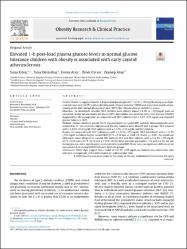Elevated 1-h post-load plasma glucose levels in normal glucose tolerance children with obesity is associated with early carotid atherosclerosis
Künye
Kılınç, S., Demirtaş, T., Atay, E., Ceran, Ö. ve Atay, Z. (2020). Elevated 1-h post-load plasma glucose levels in normal glucose tolerance children with obesity is associated with early carotid atherosclerosis. Obesity Research & Clinical Practice, 14(2), 136-141. https://dx.doi.org/10.1016/j.orcp.2020.02.001Özet
Context: Evidence suggests thatthe 1-h post-load plasma glucose (1-h PG) ≥155 mg/dL during an oral glucose tolerance test(OGTT) predicts development oftype 2 diabetes (T2DM) and associated complications, among adults with normal glucose tolerance (NGT), but relevant data on children is scarce. Objectives: To investigate whether NGT children with obesity whose 1-h PG is ≥155 mg/dL have an increased carotid intima-media thickness (IMT) and exhibit non-alcoholic fatty liver disease (NAFLD) diagnosed by ultrasonography, as compared with NGT subjects with 1-h PG <155 mg/dL and impaired glucose tolerance (IGT). Methods: Cardio-metabolic profile, OGTT, measurements of carotid IMT and liver ultrasonography were analyzed in 171 non-diabetic children with obesity. Subjects were divided into 3 groups: NGT subjects with a 1-h PG <155 mg/dL, NGT subjects with a 1-h PG ≥155 mg/dL, and IGT subjects. Results: As compared with NGT individuals with a 1-h PG <155 mg/dL, NGT individuals with a 1-h PG ≥155 mg/dL exhibited higher carotid IMT (0.75 ± 0.15 mm vs. 0.68 ± 0.15 mm; p < 0.05). No significant differences were observed in carotid IMT between IGT and NGT subjects with a 1-h PG ≥155 mg/dL (0.75 ± 0.18 mm vs 0.75 ± 0.15 mm; p > 0.05). Of the three glycemic parameters, 1-h and 2-h PG, but not fasting glucose, were significantly correlated with carotid IMT. There were no significant differences for increased risk of having NAFLD between the three groups. Conclusions: These data suggest that a value of 1-h PG ≥155 mg/dL in children and adolescents with obesity is as important as IGT with respect to cardiovascular risks.
WoS Q Kategorisi
Q4Scopus Q Kategorisi
Q2Kaynak
Obesity Research & Clinical PracticeCilt
14Sayı
2Koleksiyonlar
- Makale Koleksiyonu [3770]
- PubMed İndeksli Yayınlar Koleksiyonu [4223]
- Scopus İndeksli Yayınlar Koleksiyonu [6561]
- WoS İndeksli Yayınlar Koleksiyonu [6621]


















